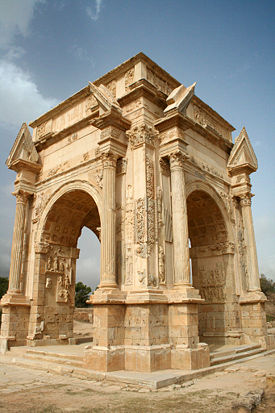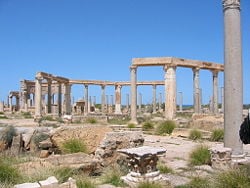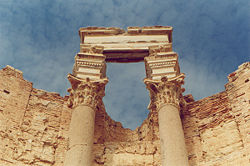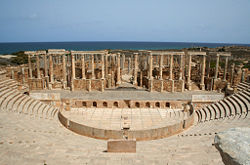Difference between revisions of "Leptis Magna" - New World Encyclopedia
m (Robot: Remove claimed tag) |
Mary Anglin (talk | contribs) |
||
| Line 1: | Line 1: | ||
| − | |||
{{images OK}} | {{images OK}} | ||
{{ready}} | {{ready}} | ||
{{Infobox World Heritage Site | {{Infobox World Heritage Site | ||
| WHS = Archaeological Site of Leptis Magna | | WHS = Archaeological Site of Leptis Magna | ||
| − | | Image = [[Image:Leptis_Magna_Arch_of_Septimus_Severus.jpg| | + | | Image = [[Image:Leptis_Magna_Arch_of_Septimus_Severus.jpg|275px|Arch of Septimius Severus]] |
| State Party = [[Image:Flag of Libya.svg|22px]] [[Libyan Arab Jamahiriya]] | | State Party = [[Image:Flag of Libya.svg|22px]] [[Libyan Arab Jamahiriya]] | ||
| Type = Cultural | | Type = Cultural | ||
| Line 15: | Line 14: | ||
}} | }} | ||
| − | '''Leptis Magna''', also known as Lectis Magna (or '''Lepcis Magna''' as it is sometimes spelled), also called '''Lpqy''' or '''Neapolis''', was a prominent city of the [[Roman Empire]]. Its ruins are located in [[Al Khums]], [[Libya]], 130 km east of [[Tripoli]], on the coast where the Wadi Lebda meets the sea. | + | '''Leptis Magna''', also known as Lectis Magna (or '''Lepcis Magna''' as it is sometimes spelled), also called '''Lpqy''' or '''Neapolis''', was a prominent city of the [[Roman Empire]]. Its ruins are located in [[Al Khums]], [[Libya]], 130 km east of [[Tripoli]], on the coast where the Wadi Lebda meets the sea. The site is one of the most spectacular and unspoilt Roman ruins in the Mediterranean. |
== History == | == History == | ||
| + | Leptis Magna was largest city of the ancient region of [[Tripolitania]], located on the coast of the [[Mediterranean Sea]] in what is now [[Libya]]. The present-day city of [[Al-Khums]] is located 2 miles west of the ancient site. | ||
| + | |||
| − | The city appears to have been founded by [[Phoenicia]]n colonists sometime around 1100 B.C.E., although it did not achieve prominence until [[Carthage]] became a major power in the [[Mediterranean Sea]] in the | + | The city appears to have been founded by [[Phoenicia]]n colonists sometime around 1100 B.C.E., although it did not achieve prominence until [[Carthage]] became a major power in the [[Mediterranean Sea]] in the 4th century B.C.E.. It nominally remained part of Carthage's dominions until the end of the [[Third Punic War]] in 146 B.C.E., and then became part of the [[Roman Republic]], although from about 200 B.C.E. onward it was for all intents and purposes an independent city. |
[[Image:Leptis Magna market place April 2004.jpg|thumb|left|250px|Market place]] | [[Image:Leptis Magna market place April 2004.jpg|thumb|left|250px|Market place]] | ||
[[Image:Leptis_Magna_B2.jpg|thumb|left|250px|Severan Basilica]] | [[Image:Leptis_Magna_B2.jpg|thumb|left|250px|Severan Basilica]] | ||
| Line 27: | Line 28: | ||
Leptis achieved its greatest prominence beginning in 193, when a native son, Lucius [[Septimius Severus]], became [[Roman Emperors|emperor]]. He favored his hometown above all other provincial cities, and the buildings and wealth he lavished on it made Leptis Magna the third most-important city in Africa, rivaling Carthage and [[Alexandria]]. In 205, he and the imperial family visited the city and received great honors. | Leptis achieved its greatest prominence beginning in 193, when a native son, Lucius [[Septimius Severus]], became [[Roman Emperors|emperor]]. He favored his hometown above all other provincial cities, and the buildings and wealth he lavished on it made Leptis Magna the third most-important city in Africa, rivaling Carthage and [[Alexandria]]. In 205, he and the imperial family visited the city and received great honors. | ||
| − | Among the changes that Severus introduced was to create a magnificent new forum, and to rebuild the docks. | + | Among the changes that Severus introduced was to create a magnificent new forum, and to rebuild the docks. The natural harbour had a tendency to silt up, but the Severan changes made this worse and the eastern wharves are extremely well-preserved, since they were hardly used. |
| − | Leptis over-extended itself at this period. | + | Leptis over-extended itself at this period. During the [[Crisis of the Third Century]], when trade declined precipitously, Leptis Magna's importance also fell into a decline, and by the middle of the [[4th century|fourth century]], large parts of the city had been abandoned. Ammianus Marcellinus recounts that the crisis was worsened by a corrupt Roman governor named Romanus during a major tribal raid who demanded bribes to protect the city. The ruined city could not pay these, and complained to the emperor Valentianian. Romanus then bribed people at court and arranged for the Leptan envoys to be punished 'for bringing false accusations'. It enjoyed a minor renaissance beginning in the reign of the emperor [[Theodosius I]]. |
In 439, Leptis Magna and the rest of the cities of [[Tripolitania]] fell under the control of the [[Vandals]] when their king, [[Gaiseric]], captured Carthage from the Romans and made it his capital. Unfortunately for the future of Leptis Magna, Gaiseric ordered the city's walls demolished so as to dissuade its people from rebelling against Vandal rule. But the people of Leptis and the Vandals both paid a heavy price for this in 523, when a group of [[Berber people|Berber]] raiders sacked the city. | In 439, Leptis Magna and the rest of the cities of [[Tripolitania]] fell under the control of the [[Vandals]] when their king, [[Gaiseric]], captured Carthage from the Romans and made it his capital. Unfortunately for the future of Leptis Magna, Gaiseric ordered the city's walls demolished so as to dissuade its people from rebelling against Vandal rule. But the people of Leptis and the Vandals both paid a heavy price for this in 523, when a group of [[Berber people|Berber]] raiders sacked the city. | ||
| − | [[Belisarius]] recaptured Leptis Magna in the name of Rome 10 years later, and in 534 he destroyed the kingdom of the Vandals. Leptis became a provincial capital of the Eastern Roman Empire (see [[Byzantine Empire]]), but never recovered from the destruction wreaked upon it by the Berbers. It was the site of a massacre of [[Berber chiefs]] by the Roman authorities in 543.<ref>"Leptis Magna" | + | [[Belisarius]] recaptured Leptis Magna in the name of Rome 10 years later, and in 534 he destroyed the kingdom of the Vandals. Leptis became a provincial capital of the Eastern Roman Empire (see [[Byzantine Empire]]), but never recovered from the destruction wreaked upon it by the Berbers. It was the site of a massacre of [[Berber chiefs]] by the Roman authorities in 543.<ref>"Leptis Magna," Catholic Encyclopedia.</ref> By the time of the Arab conquest of Tripolitania in the 650s, the city was abandoned except for a Byzantine garrison force. |
Today, the site of Leptis Magna is the site of some of the most impressive ruins of the Roman period. | Today, the site of Leptis Magna is the site of some of the most impressive ruins of the Roman period. | ||
| Line 39: | Line 40: | ||
==New discoveries== | ==New discoveries== | ||
| − | In June 2005 it was revealed that archaeologists from the [[University of Hamburg]] had been working along the coast of Libya when they uncovered a 30 [[Foot (unit of length)|ft]] length of five colorful [[mosaic]]s created during the [[1st century|1st]] or [[2nd century]]. The mosaics show with exceptional clarity depictions of a warrior in combat with a deer, four young men wrestling a wild bull to the ground, and a gladiator resting in a state of fatigue, staring at his slain opponent. | + | In June 2005 it was revealed that archaeologists from the [[University of Hamburg]] had been working along the coast of Libya when they uncovered a 30 [[Foot (unit of length)|ft]] length of five colorful [[mosaic]]s created during the [[1st century|1st]] or [[2nd century]]. The mosaics show with exceptional clarity depictions of a warrior in combat with a deer, four young men wrestling a wild bull to the ground, and a gladiator resting in a state of fatigue, staring at his slain opponent. The mosaics decorated the walls of a cold plunge pool in a [[bath house]] within a Roman villa at [[Wadi Lebda]] in Leptis Magna. The gladiator mosaic is noted by scholars as one of the finest examples of representational mosaic art ever seen — a "masterpiece comparable in quality with the Alexander mosaic in [[Pompeii]]." The mosaics were originally discovered in 2000, but were kept secret to avoid looting. They are currently on display in the Leptis Magna Museum.<ref>Alberge, Dalya, [http://www.timesonline.co.uk/article/0,,3-1651931,00.html "Roman Mosaic 'Worthy of Botticelli"], ''The Times Online'', June 2005. Retrieved December 20, 2007.</ref> |
| − | <br> | + | <br/> |
| − | <br> | + | <br/> |
==Notes== | ==Notes== | ||
<div class="references-small"> | <div class="references-small"> | ||
| Line 60: | Line 61: | ||
[[Category:History]] | [[Category:History]] | ||
[[Category:Archaeological sites]] | [[Category:Archaeological sites]] | ||
| + | [[Category:Geography]] | ||
| + | [[Category:Cities]] | ||
{{credits|176218832}} | {{credits|176218832}} | ||
Revision as of 02:45, 24 April 2008
| Archaeological Site of Leptis Magna* | |
|---|---|
| UNESCO World Heritage Site | |

| |
| State Party | 22px Libyan Arab Jamahiriya |
| Type | Cultural |
| Criteria | i, ii, iii |
| Reference | 183 |
| Region** | Arab States |
| Inscription history | |
| Inscription | 1982 (6th Session) |
| * Name as inscribed on World Heritage List. ** Region as classified by UNESCO. | |
Leptis Magna, also known as Lectis Magna (or Lepcis Magna as it is sometimes spelled), also called Lpqy or Neapolis, was a prominent city of the Roman Empire. Its ruins are located in Al Khums, Libya, 130 km east of Tripoli, on the coast where the Wadi Lebda meets the sea. The site is one of the most spectacular and unspoilt Roman ruins in the Mediterranean.
History
Leptis Magna was largest city of the ancient region of Tripolitania, located on the coast of the Mediterranean Sea in what is now Libya. The present-day city of Al-Khums is located 2 miles west of the ancient site.
The city appears to have been founded by Phoenician colonists sometime around 1100 B.C.E., although it did not achieve prominence until Carthage became a major power in the Mediterranean Sea in the 4th century B.C.E.. It nominally remained part of Carthage's dominions until the end of the Third Punic War in 146 B.C.E., and then became part of the Roman Republic, although from about 200 B.C.E. onward it was for all intents and purposes an independent city.
Leptis Magna remained as such until the reign of the Roman emperor Tiberius, when the city and the surrounding area were formally incorporated into the empire as part of the province of Africa. It soon became one of the leading cities of Roman Africa and a major trading post.
Leptis achieved its greatest prominence beginning in 193, when a native son, Lucius Septimius Severus, became emperor. He favored his hometown above all other provincial cities, and the buildings and wealth he lavished on it made Leptis Magna the third most-important city in Africa, rivaling Carthage and Alexandria. In 205, he and the imperial family visited the city and received great honors.
Among the changes that Severus introduced was to create a magnificent new forum, and to rebuild the docks. The natural harbour had a tendency to silt up, but the Severan changes made this worse and the eastern wharves are extremely well-preserved, since they were hardly used.
Leptis over-extended itself at this period. During the Crisis of the Third Century, when trade declined precipitously, Leptis Magna's importance also fell into a decline, and by the middle of the fourth century, large parts of the city had been abandoned. Ammianus Marcellinus recounts that the crisis was worsened by a corrupt Roman governor named Romanus during a major tribal raid who demanded bribes to protect the city. The ruined city could not pay these, and complained to the emperor Valentianian. Romanus then bribed people at court and arranged for the Leptan envoys to be punished 'for bringing false accusations'. It enjoyed a minor renaissance beginning in the reign of the emperor Theodosius I.
In 439, Leptis Magna and the rest of the cities of Tripolitania fell under the control of the Vandals when their king, Gaiseric, captured Carthage from the Romans and made it his capital. Unfortunately for the future of Leptis Magna, Gaiseric ordered the city's walls demolished so as to dissuade its people from rebelling against Vandal rule. But the people of Leptis and the Vandals both paid a heavy price for this in 523, when a group of Berber raiders sacked the city.
Belisarius recaptured Leptis Magna in the name of Rome 10 years later, and in 534 he destroyed the kingdom of the Vandals. Leptis became a provincial capital of the Eastern Roman Empire (see Byzantine Empire), but never recovered from the destruction wreaked upon it by the Berbers. It was the site of a massacre of Berber chiefs by the Roman authorities in 543.[1] By the time of the Arab conquest of Tripolitania in the 650s, the city was abandoned except for a Byzantine garrison force.
Today, the site of Leptis Magna is the site of some of the most impressive ruins of the Roman period.
New discoveries
In June 2005 it was revealed that archaeologists from the University of Hamburg had been working along the coast of Libya when they uncovered a 30 ft length of five colorful mosaics created during the 1st or 2nd century. The mosaics show with exceptional clarity depictions of a warrior in combat with a deer, four young men wrestling a wild bull to the ground, and a gladiator resting in a state of fatigue, staring at his slain opponent. The mosaics decorated the walls of a cold plunge pool in a bath house within a Roman villa at Wadi Lebda in Leptis Magna. The gladiator mosaic is noted by scholars as one of the finest examples of representational mosaic art ever seen — a "masterpiece comparable in quality with the Alexander mosaic in Pompeii." The mosaics were originally discovered in 2000, but were kept secret to avoid looting. They are currently on display in the Leptis Magna Museum.[2]
Notes
- ↑ "Leptis Magna," Catholic Encyclopedia.
- ↑ Alberge, Dalya, "Roman Mosaic 'Worthy of Botticelli", The Times Online, June 2005. Retrieved December 20, 2007.
ReferencesISBN links support NWE through referral fees
- Talbert, Richard J. A., and Roger S. Bagnall. Barrington Atlas of the Greek and Roman World. Princeton, N.J.: Princeton University Press, 2000. ISBN 069103169X
External links
All links Retrieved December 20, 2007.
- Comprehensive website, by an archaeologist working on the site
- The Circus at Leptis Magna - Satellite View Google Maps
Credits
New World Encyclopedia writers and editors rewrote and completed the Wikipedia article in accordance with New World Encyclopedia standards. This article abides by terms of the Creative Commons CC-by-sa 3.0 License (CC-by-sa), which may be used and disseminated with proper attribution. Credit is due under the terms of this license that can reference both the New World Encyclopedia contributors and the selfless volunteer contributors of the Wikimedia Foundation. To cite this article click here for a list of acceptable citing formats.The history of earlier contributions by wikipedians is accessible to researchers here:
The history of this article since it was imported to New World Encyclopedia:
Note: Some restrictions may apply to use of individual images which are separately licensed.


